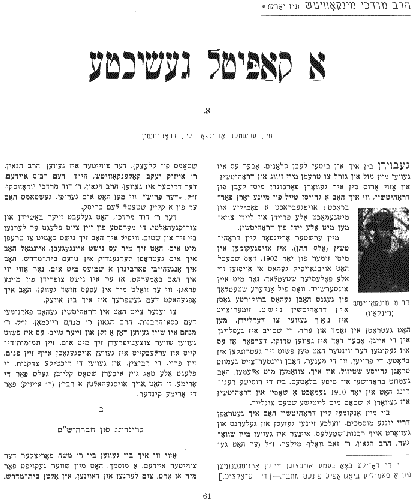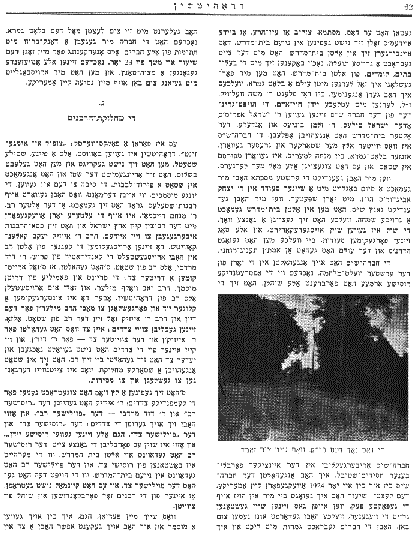 [
Page 61
]
[
Page 61
]
Rabbi Mordechai Minkovitch (New York)*
 [
Page 61
]
[
Page 61
]
Rabbi Mordechai Minkovitch (New York)*
 [
Page 62
]
[
Page 62
]
He probably did this to avoid the Evil Eye by not having both sons-in-law
located in the New House of Study. Joining the Old House of Study was very
beneficial. After getting to know the householders and scholars of the Old
House of Study, I was asked to teach a class in Talmud to the congregants,
which I was only happy to do. Until them the late R. Moshe Velvel studied the
Jewish legal text,
Chayei Adam
with a few men. The main founders of the Talmud study group were R. Yisrael
Ephraim's (Yisrael Tilles), R. Zalman Bunyes and others. The Old House of Study
started to come alive. The Talmud study group steadily grew stronger and
larger. Our Talmud class between the Afternoon [Minchah] and Evening [Ma'ariv]
prayers became popular throughout town, and always drew more participants.
When we completed our first
tractate of the Talmud, we celebrated the occasion with a beautiful meal in R.
Yitzchak Avigdor's home. Years later, when we completed the entire Talmud,
there was a great celebration in the Old House of Study that lasted a whole
week. The synagogue was decorated, and festive meals were served every day,
where the appropriate blessings were pronounced. Everybody had a real enjoyable
time.
[Photo:] The street after the
bridge, leading to the Sand.
The Talmud study group
continued during the First World War. After the retreating Russian army burned
down all the synagogues, the Talmud study group moved to the only remaining
chassidic synagogue. I continued the Talmud study group until I left for the
United States in 1924. I gave my final class in my home to an overflow crowd.
As the wagons stood on the street ready to depart for the train station, the
class participants arrived with copies of the Talmud and lamps; I taught my
final page of Talmud to them. The study group then offered me a thank-you
letter signed by all of the participants in recognition for my lectures over
the previous 23 years. Then the participants started a joyous dance and
accompanied me with song all the way to the train station on my way to the
United States.
C.
The rabbinical disputes
There is an old saying:
"Too many isn't healthy." Drohitchin was known as a fine
shtetl
and a quiet place. No one argued, and everyone lived together in peace.
However, Satan found an opening to create conflict in the community. The reason
was the young ordained rabbis, as mentioned previously, who were waiting for
rabbinical positions. What happened was that the elderly rabbi, Rabbi Menachem
Reichman, decided to move to Palestine with his wife, and handed over his
position to his son-in-law, Rabbi Isaac Yaakov Kalenkovitch. The old rabbi's
opponents came out in the open, recommending that the position be filled by the
non-chassid, Rabbi David Mordechai. The friends and family of the third
ordained rabbi, Rabbi Ze'ev Wolf Miller, suggested a third choice. However, a
wise Jew suggested appointing Rabbi Miller as the head rabbinical judge, and
Rabbi Isaac as the community rabbi. Thus, there were now two groups: one group
was with Rabbi Isaac, and the other was for Rabbi David. Since neither side
wanted to give in, and each stuck by their candidate, a sharp dispute erupted
in Drohitchin, leading to violence and informing to the non-Jewish authorities.
There was a scoffer who gave
names to both camps: he called R. Isaac the "Russian rabbi," and R.
David Mordechai the "Polish rabbi." This is also how he referred to
both groups: the "Russian" group and the "Polish" group
– even though all the Jews were Russian Jews. This stayed this way the
entire time. The Russian rabbi prayed in the Old House of Study, and the Polish
rabbi prayed in the New House of Study. The Polish group had the upper hand,
and it never happened that either of the rabbis would end up in the synagogue
of the other.
Where did I fit in all this?
Even though I was also ordained, I could have had a group of my own in
JewishGen, Inc. makes no representations regarding the accuracy of
the translation. The reader may wish to refer to the original material
for verification.
JewishGen is not responsible for inaccuracies or omissions in the original work and cannot rewrite or edit the text to correct inaccuracies and/or omissions.
Our mission is to produce a translation of the original work and we cannot verify the accuracy of statements or alter facts cited.
 Drogichin, Belarus
Drogichin, Belarus
 Yizkor Book Project
Yizkor Book Project
 JewishGen Home Page
JewishGen Home Page
Copyright © 1999-2025 by JewishGen, Inc.
Updated 7 Dec 2001 by LA